Synthesis and Characterization of Bipyridine-Based Polyaminal Network for CO2 Capture
Abstract
:1. Introduction
2. Experimental Section
2.1. Materials
2.2. Synthesis of Porous Organic Polymers Based on Melamine and [2,2′-Bipyridine]-5,5′-Dicarbaldehyde
2.3. Instrumentation
3. Result and Discussion
Synthesis and Characterisation
4. Conclusions
Supplementary Materials
Author Contributions
Funding
Institutional Review Board Statement
Informed Consent Statement
Data Availability Statement
Acknowledgments
Conflicts of Interest
References
- Tang, F.; Hou, J.; Liang, K.; Huang, J.; Liu, Y.-N. Melamine-Based Metal-Chelating Porous Organic Polymers for Efficient CO2 Capture and Conversion. Eur. J. Inorg. Chem. 2018, 37, 4175–4180. [Google Scholar] [CrossRef]
- Schwab, M.G.; Fassbender, B.; Spiess, H.W.; Thomas, A.; Feng, X.; Müllen, K. Catalyst-free preparation of melamine-based microporous polymer networks through Schiff base chemistry. J. Am. Chem. Soc. 2009, 131, 7216–7217. [Google Scholar] [CrossRef]
- Li, G.; Fang, H.; Jiang, D.; Zheng, G. Porous organic polymers based on melamine and 5.5-bis(bromomethyl)-2,2-bipyridine: Functionalization with lanthanide ions for chemical sensing and highly efficient adsorption of methyl orange. New J. Chem. 2018, 42, 19734–19739. [Google Scholar] [CrossRef]
- Sandín, R.; González-Lucas, M.; Sobarzo, P.A.; Terraza, C.A.; Maya, E.M. Microwave-assisted melamine-based polyaminals and their application for metal cations adsorption. Eur. Polym. J. 2021, 155, 110562. [Google Scholar] [CrossRef]
- Ghanbaria, T.; Abnisab, F.; Dauda, W.M. A review on production of metal organic frameworks (MOF) for CO2 adsorption. Sci. Total Environ. 2020, 707, 135090. [Google Scholar] [CrossRef]
- Yang, F.; Li, Y.; Zhang, T.; Zhao, Z.; Xing, G.; Chen, L. Docking site modulation of isostructural covalent organic frameworks for CO2 fixation. Eur. J. Chem. 2020, 26, 4510–4514. [Google Scholar] [CrossRef] [PubMed]
- Rehman, A.; Park, S.J. Highlighting the relative effects of surface characteristics and porosity on CO2 capture by adsorbents templated from melamine-based polyaminals. J. Solid State Chem. 2018, 258, 573–581. [Google Scholar] [CrossRef]
- Adelabu, I.O.; Saleh, T.A.; Garrison, T.F.; Al Hamouz, O.C.S. ynthesis of polyamine-CNT composites for the removal of toxic cadmium metal ions from wastewater. J. Mol. Liq. 2020, 297, 111827. [Google Scholar] [CrossRef]
- Taskin, O.S.; Ersoy, N.; Aksu, A.; Kiskan, B.; Balkis, N.; Yagci, Y. Melamine-based microporous polymer for highly efficient removal of copper(II) from aqueous solution. Polym. Int. 2016, 65, 439–445. [Google Scholar] [CrossRef]
- Rehman, A.; Park, S.J. Influence of nitrogen moieties on CO2 capture by polyaminal-based porous carbon. Macromol. Res. 2017, 25, 1035–1042. [Google Scholar] [CrossRef]
- Peng, R.; Chen, G.; Zhou, F.; Man, R.; Huang, J. Catalyst-free synthesis of triazine-based porous organic polymers for Hg2+ adsorptive removal from aqueous solution. Chem. Eng. J. 2019, 371, 260–266. [Google Scholar] [CrossRef]
- Zhang, S.; Li, X.; Gong, W.; Sun, T.; Wang, Z.; Ning, G. Pillar[5]arene-Derived Microporous Polyaminal Networks with Enhanced Uptake Performance for CO2 and Iodine. Ind. Eng. Chem. Res. 2020, 59, 3269–3278. [Google Scholar] [CrossRef]
- Liang, J.; Huang, Y.B.; Cao, R. Metal–organic frameworks and porous organic polymers for sustainable fixation of carbon dioxide into cyclic carbonates. Coord. Chem. Rev. 2019, 378, 32–65. [Google Scholar] [CrossRef]
- Senthilkumarana, M.; Saravanana, C.; Sethuramana, V.; Puthiarajb, P.; Mareeswaran, P.M. Nitrogen-rich polyaminal porous network for CO2 uptake studies and preparation of carbonized materials. Eur. Polym. J. 2020, 124, 109477. [Google Scholar] [CrossRef]
- Zhang, B.; Yan, J.; Li, G.; Wang, Z. Carboxyl-, Hydroxyl-, and Nitro Functionalized Porous Polyaminals for Highly Selective CO2 Capture. ACS Appl. Polym. Mater. 2019, 1, 1524–1531. [Google Scholar] [CrossRef]
- Liu, C.; Xia, M.; Zhang, M.; Yuan, K.; Hu, F.; Yu, G.; Jian, X. One-pot synthesis of nitrogen-rich aminal- and triazine-based hierarchical porous organic polymers with highly efficient iodine adsorption. Polymer 2020, 194, 122401. [Google Scholar] [CrossRef]
- Yang, G.; Han, H.; Du, C.; Luo, Z.; Wang, Y. Facile synthesis of melamine-based porous polymer networks and their application for removal of aqueous mercury ions. Polymer 2010, 51, 6193–6202. [Google Scholar] [CrossRef]
- Rong, M.; Yang, L.; Wang, L.; Yu, J.; Qu, H.; Liu, H. Fabrication of ultramicroporous triphenylamine-based polyaminal networks for low-pressure carbon dioxide capture. J. Colloid Interface Sci. 2019, 548, 265–274. [Google Scholar] [CrossRef] [PubMed]
- Hou, S.; Tan, B. Naphthyl Substitution-Induced Fine Tuning of Porosity and Gas Uptake Capacity in Microporous Hyper-CrossLinked Amine Polymers. Macromolecules 2018, 51, 2923–2931. [Google Scholar] [CrossRef]
- McMurry, J. Organic Chemistry, 8th ed.; Cengage Learning: Toronto, ON, Canada, 2011. [Google Scholar]
- Ibrahim, M.; Tashkandi, N.; Hadjichristidis, N.; Alkayal, N. Synthesis of Naphthalene-Based Polyaminal-Linked Porous Polymers for Highly Effective Uptake of CO2 and Heavy Metals. Polymers 2022, 14, 1136. [Google Scholar] [CrossRef]
- Li, G.; Zhang, B.; Wang, Z. Facile Synthesis of Fluorinated Microporous Polyaminals for Adsorption of Carbon Dioxide and Selectivities over Nitrogen and Methane. Macromolecules 2016, 49, 2575–2581. [Google Scholar] [CrossRef]
- Wang, T.; Yao, H.; Song, N.; Yang, Y.; Shi, K.; Guan, S. Microporous polymer networks constructed from cross-linkable linear polyimides for CO2 adsorption. Microporous Mesoporous Mater. 2021, 311, 110708. [Google Scholar] [CrossRef]
- Zulfiqar, S.; Sarwar, M.; Yavuz, C. Melamine based porous organic amide polymers for CO2 capture. RSC Adv. 2014, 4, 52263–52269. [Google Scholar] [CrossRef]
- Shao, L.; Liu, M.; Sang, Y.; Huang, J. One-pot synthesis of melamine-based porous polyamides for CO2 capture. Microporous Mesoporous Mater. 2019, 285, 105–111. [Google Scholar] [CrossRef]
- Oschatz, M.; Antonietti, M. A search for selectivity to enable CO2 capture with porous adsorbents. Energy Environ. Sci. 2018, 11, 57–70. [Google Scholar] [CrossRef] [Green Version]
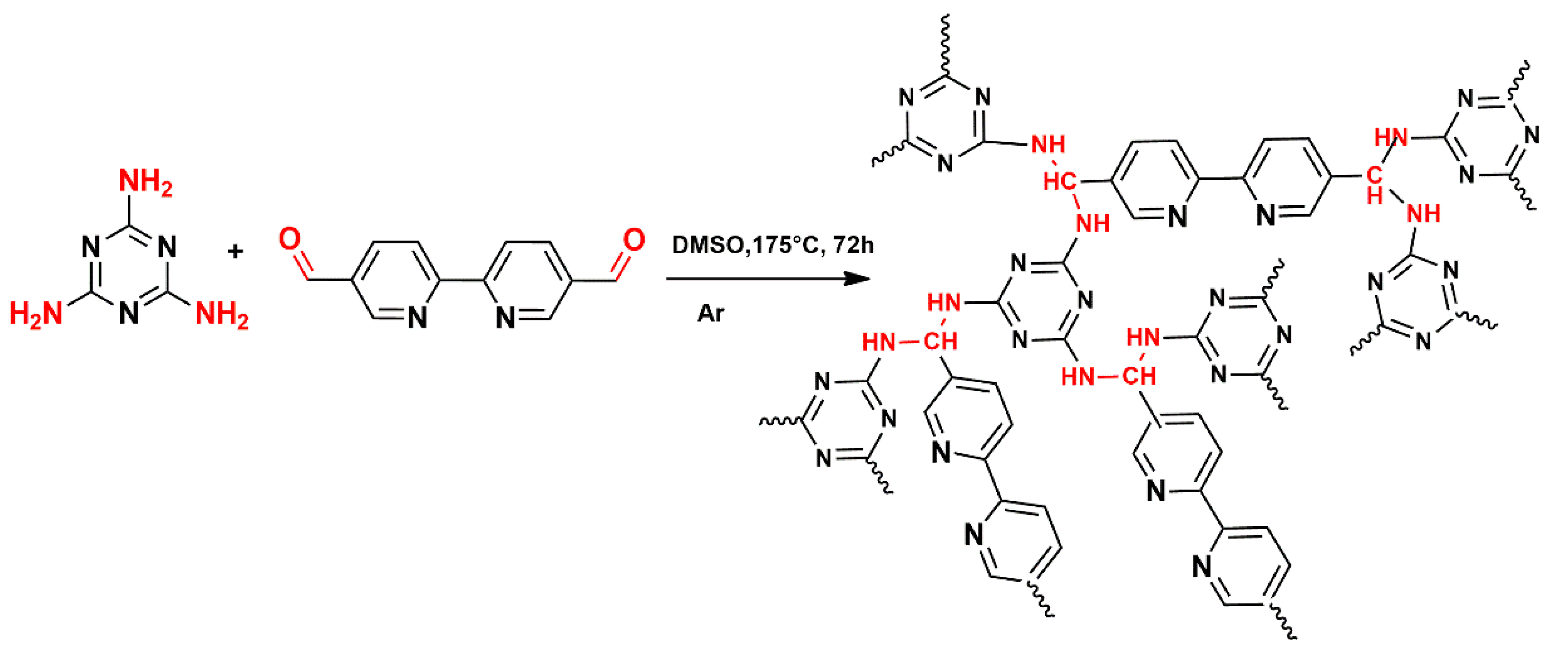

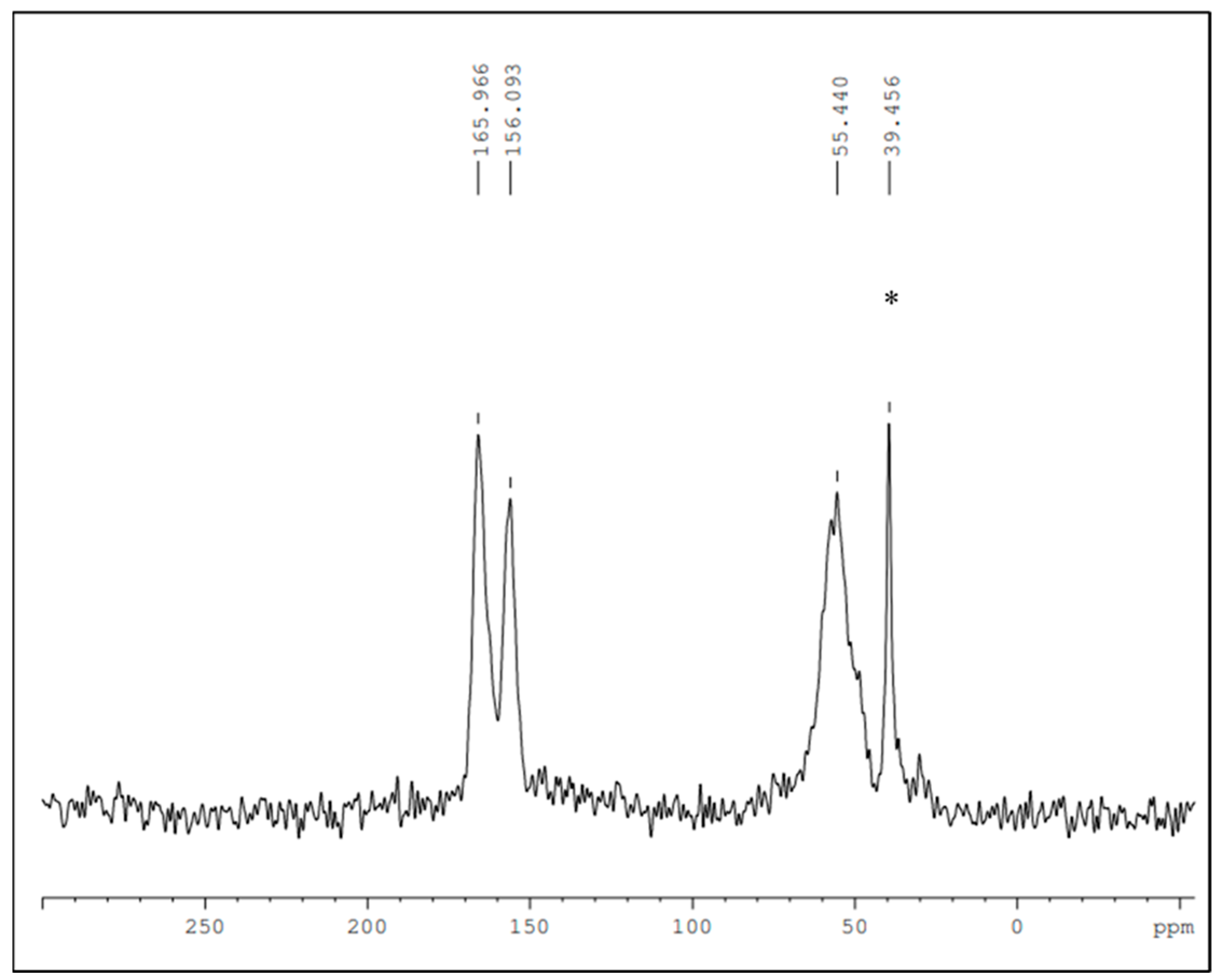


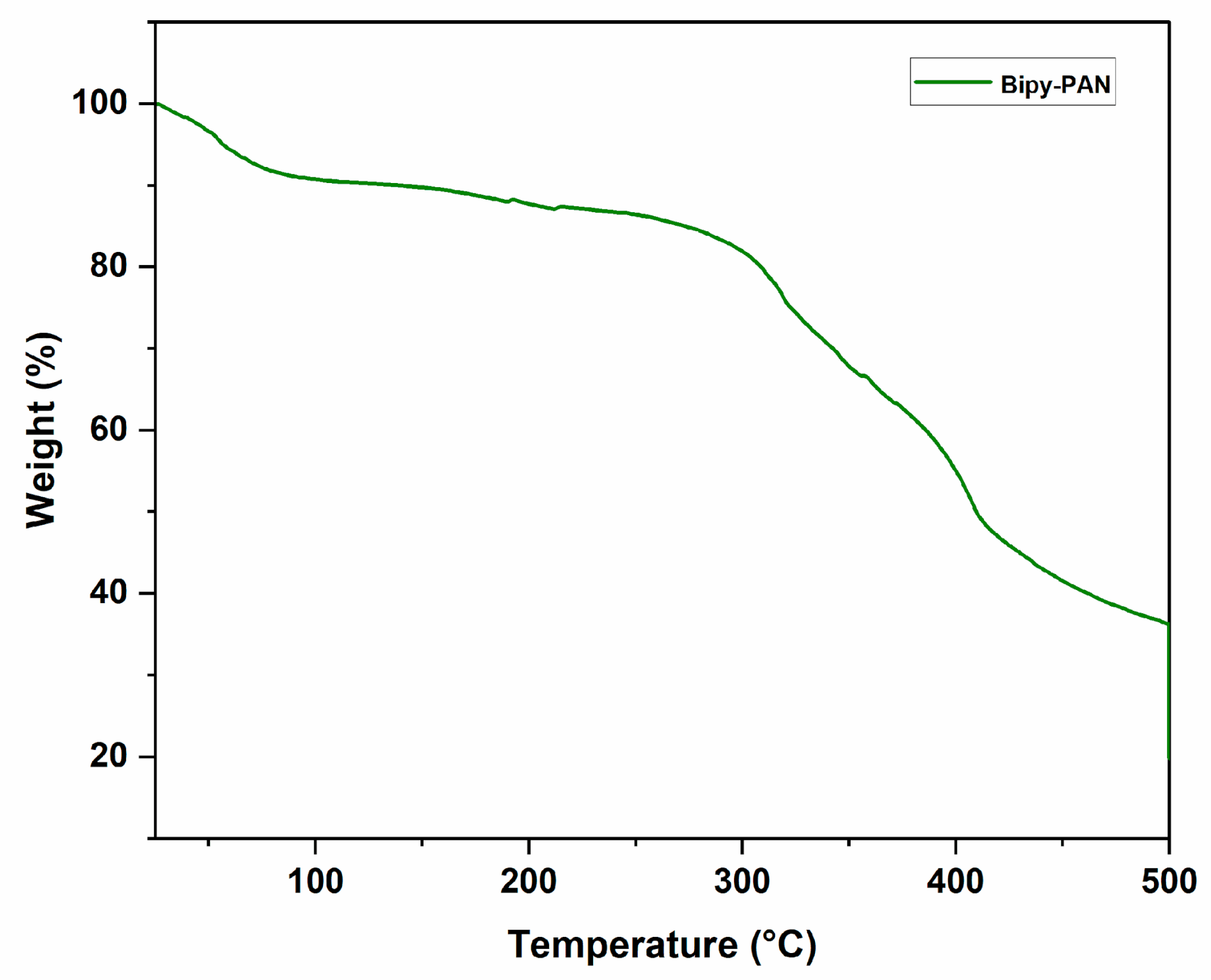
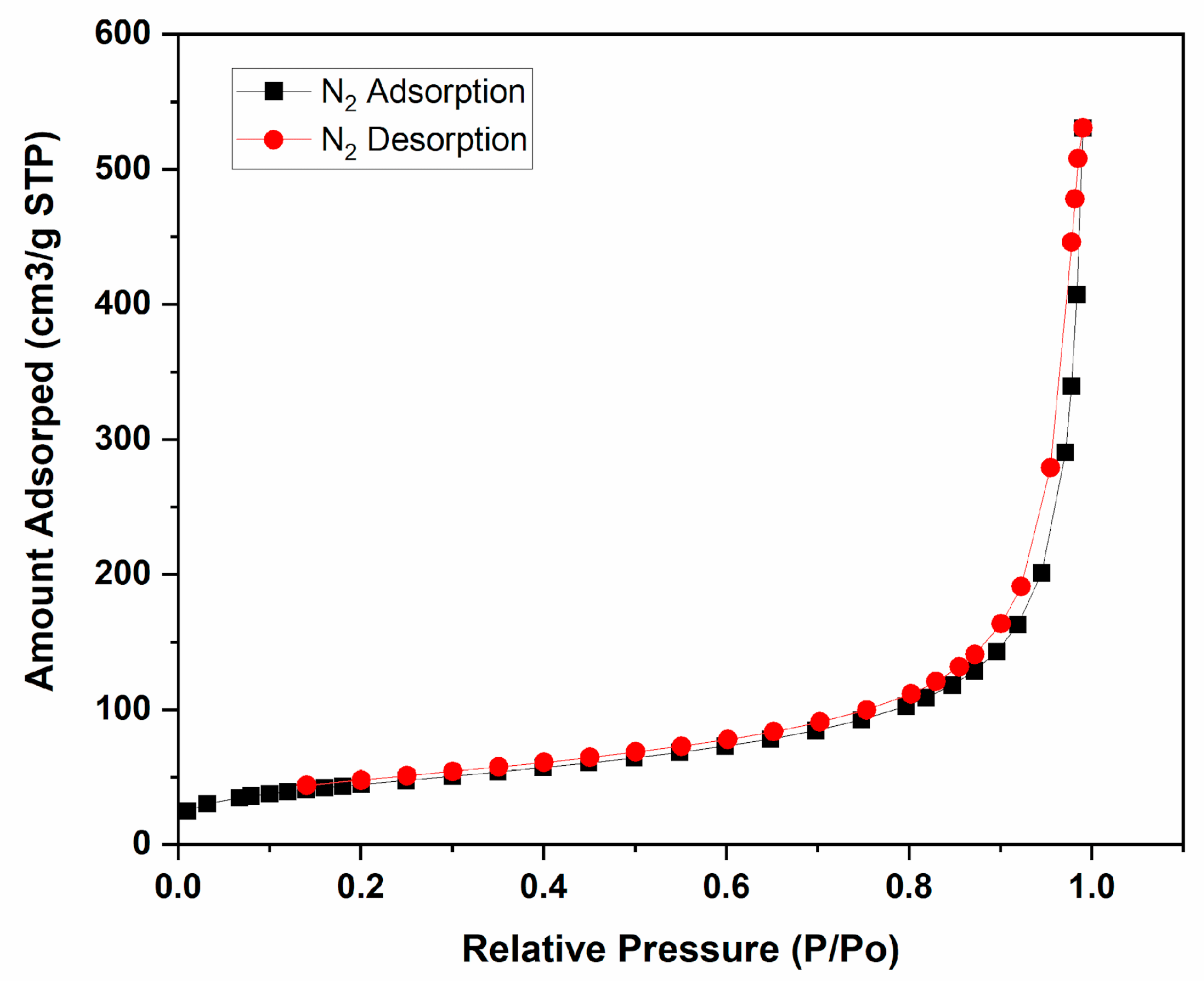
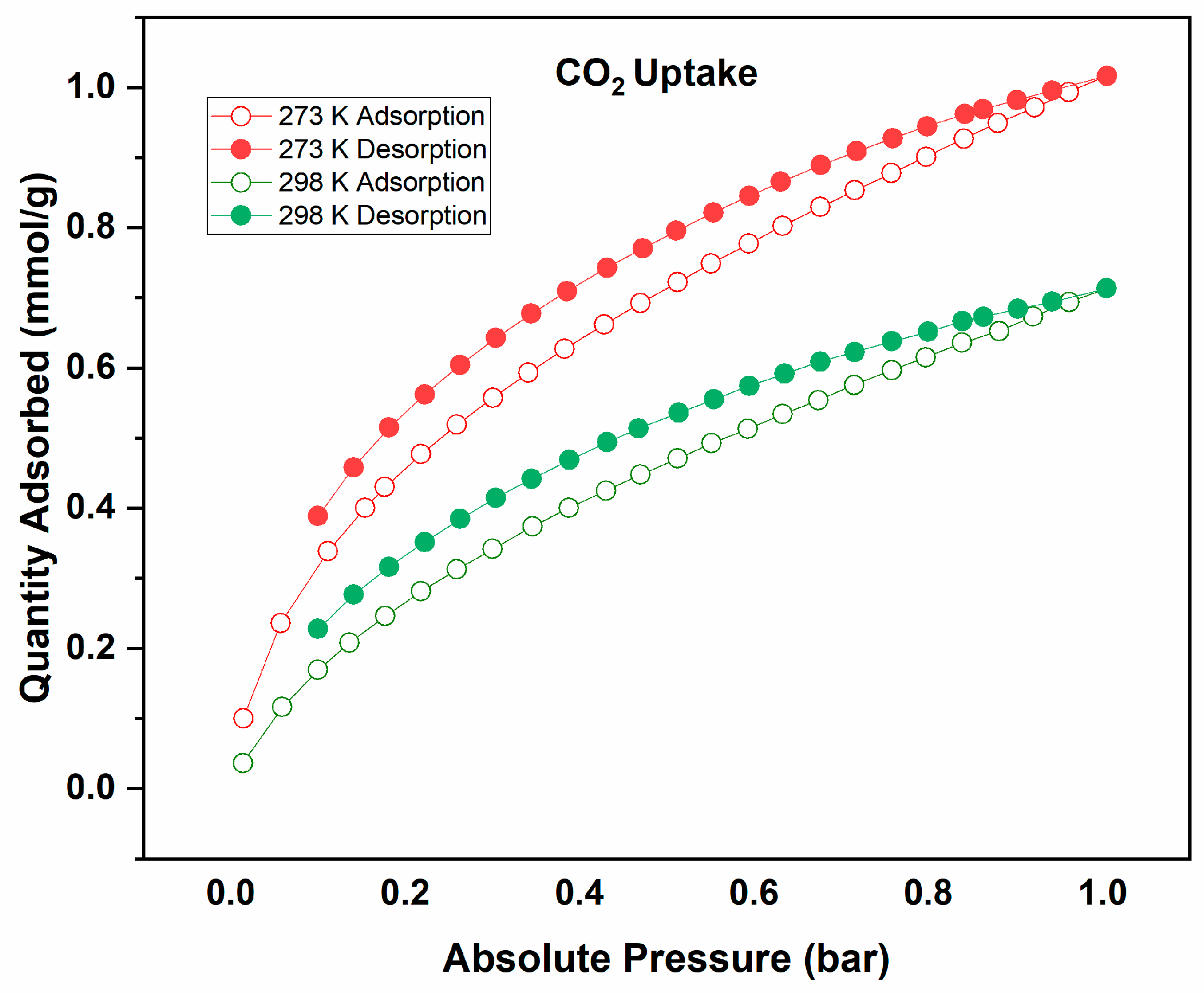
Publisher’s Note: MDPI stays neutral with regard to jurisdictional claims in published maps and institutional affiliations. |
© 2022 by the authors. Licensee MDPI, Basel, Switzerland. This article is an open access article distributed under the terms and conditions of the Creative Commons Attribution (CC BY) license (https://creativecommons.org/licenses/by/4.0/).
Share and Cite
Alkayal, N.S.; Alotaibi, M.M.; Tashkandi, N.Y.; Alrayyani, M.A. Synthesis and Characterization of Bipyridine-Based Polyaminal Network for CO2 Capture. Polymers 2022, 14, 3746. https://doi.org/10.3390/polym14183746
Alkayal NS, Alotaibi MM, Tashkandi NY, Alrayyani MA. Synthesis and Characterization of Bipyridine-Based Polyaminal Network for CO2 Capture. Polymers. 2022; 14(18):3746. https://doi.org/10.3390/polym14183746
Chicago/Turabian StyleAlkayal, Nazeeha S., Maha M. Alotaibi, Nada Y. Tashkandi, and Maymounah A. Alrayyani. 2022. "Synthesis and Characterization of Bipyridine-Based Polyaminal Network for CO2 Capture" Polymers 14, no. 18: 3746. https://doi.org/10.3390/polym14183746
APA StyleAlkayal, N. S., Alotaibi, M. M., Tashkandi, N. Y., & Alrayyani, M. A. (2022). Synthesis and Characterization of Bipyridine-Based Polyaminal Network for CO2 Capture. Polymers, 14(18), 3746. https://doi.org/10.3390/polym14183746








